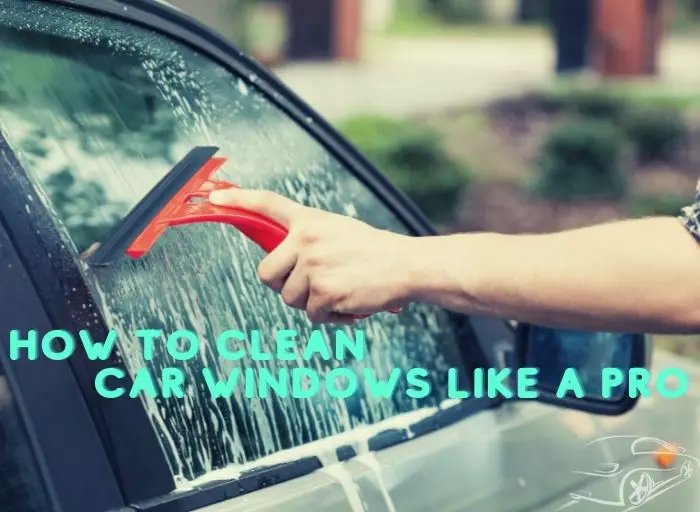
Whether you need a solution for washing the outside of your car windows or the inside of your windows, you’ve come to the right place. How to clean car windows like a pro is not so hard.
So-called ‘window cleaners’ have all sorts of tips and tricks for getting that streak-free line across your windshield. You can mix things up in order to increase shine and minimize smudges or if just want to be a bit more daring with different materials and techniques, follow our advice as we get into detailing how to polish those dirty car windows like a pro.
Table of Contents
Understanding the Basics of Car Window Cleaning
Car window cleaning is an essential part of vehicle maintenance that helps to ensure clear visibility, maintain the overall appearance of the car, and promote safe driving. Here are the basics of car window cleaning that you should know:
Importance of using the right tools and products
Using the right tools and products is crucial for effective and safe car window cleaning. Here are some key considerations:
- Microfiber cloths: These are gentle on glass and won’t leave behind lint or scratches.
- Squeegee: Opt for a high-quality squeegee with a rubber blade that provides streak-free results.
- Scrubbing brush: Use a soft-bristled brush to remove stubborn dirt and grime.
- Bucket: A clean bucket with warm water is necessary for diluting cleaning solutions and rinsing tools.
- Glass cleaner: Choose a glass cleaner specifically formulated for automotive use. Avoid using ammonia-based cleaners, as they can damage window tints and rubber seals.
Choosing the appropriate cleaning solutions
Selecting the right cleaning solutions is essential for achieving clean and clear windows without causing any damage. Consider the following points:
- Automotive glass cleaner: Look for a cleaner specifically designed for car windows. These cleaners are formulated to remove dirt, fingerprints, and other common contaminants.
- Avoid ammonia-based cleaners: As mentioned earlier, ammonia can harm window tints and rubber seals, so it’s best to steer clear of products containing ammonia.
- DIY options: A mixture of water and vinegar (in a 1:1 ratio) can work well if you prefer homemade solutions. However, ensure that your windows are not tinted, as vinegar may affect the tint.
Different types of car window glass

Car window glass can vary in terms of composition and features. The main types of car window glass include:
- Laminated glass: This type of glass is commonly used for windshields. It consists of a layer of vinyl sandwiched between two layers of glass, providing strength and safety. Avoid using abrasive tools or harsh chemicals on laminated glass.
- Tempered glass: Most side and rear windows are made of tempered glass. It is heated and rapidly cooled during manufacturing, making it stronger than regular glass. However, it can still be susceptible to scratches, so use caution while cleaning.
- Tinted glass: Some windows have a tinted film applied to them for privacy and sun protection. When cleaning tinted windows, choose products that are specifically labeled as safe for tinted glass.
Related: How to Use a Clay Bar on Glass Safely!
Items Needed to Clean Car Windows
- Microfiber towels
- Car auto-glass cleaner
- A sponge
- Cleaning cloths
In order to clean the outside windows, you’ll need:
1. Spray bottle
Fill the bottle with 1/2 vinegar and 1/2 water. Or you can use window cleaner to clean the windows’ inside and outside. Use a squeegee to wipe away any streaks or excess water, soap, or glass cleaner after spraying on your windshield, side windows, and rear window. Spray and wipe everything clean with the same solution.
2. Water
You will need a water source to polish and clean the outside of your car windows. If you don’t have access to a hose or watering can, fill a bowl or bucket with water. Wet down the window thoroughly before applying soap and stationary.
3. Sponge
A sponge will help you dry the windows to avoid streaks as well as pull up any dirt or grime that your water and soap solution might not pull off easily.
4. Wet/Dry Vacuum
If you don’t have access to a water source, a wet or dry vacuum can be used to remove the water from your car windows and sides. This is only necessary if you don’t have a hose or watering can.

To clean the inside of your car windows, you’ll need:
1. Glass cleaner
If you’re cleaning your windows with a mix of vinegar and water, try something with a more home-friendly scent. Citrus-scented, such as Windex or Pledge, will ensure that your vehicle’s windows are clean without leaving a strong scent in the vehicle. Wet the area with some water and dust it off after dries.
2. Vacuum
You can use either a wet or dry method to clean the inside of windows, depending on how dirty they are.
3. Wet/Dry Vacuum
If you don’t have access to a water source, a wet or dry vacuum can be used to remove the water from your car windows and sides.
4. Towel
A towel can be used for drying any dirty glass item in your car windows, dash, console, door panels, etc..
5. Cleaning Cloths
You can use wet or dry cloths to dry any excess water and prevent streaks.
6. Dish Soap
Using dish soap is unnecessary, but some customers have stated that they found it useful for removing stubborn grime that other cleaners couldn’t remove from their windows.
7. Smart Wool Dry Cloth
This is like a waffle weave, soft microfiber drying cloth.
How to Clean the Exterior Car Windows
Cleaning the exterior car windows involves a few simple steps to ensure a streak-free and sparkling finish. Here’s a step-by-step guide:

Step 1: Wetting the window surface
Begin by wetting the exterior window surface with clean water. You can use a hose, a bucket of water, or a spray bottle. This helps remove loose dirt and debris, making cleaning easier.
Step 2: Applying the glass cleaner
Next, spray the glass cleaner onto the wet window surface. Ensure that you use a glass cleaner specifically designed for automotive use. Work your way down from the top, applying the cleaner evenly across the entire window.
Step 3: Using the squeegee for optimal cleaning
Take the squeegee and place it at the top corner of the window. Tilt it slightly to create an angle with the glass. Pull the squeegee down along the window straight from top to bottom with firm and even pressure. Repeat this motion, slightly overlapping each stroke until you reach the other side of the window. Wipe the rubber blade of the squeegee with a clean cloth after each stroke to prevent streaks.
Check out: Car Interior Detailing: All You Need to Know
Step 4: Drying and buffing the windows for a streak-free finish
After squeegeeing the entire window, dry and buff the surface with a clean microfiber cloth. Start at the top and work your way down, using gentle circular motions. Ensure that you dry the edges and corners thoroughly to prevent water spots.
Tips for a successful exterior window cleaning:
- Work on one window at a time to maintain control and prevent the cleaner from drying before you can squeegee.
- Clean the windows in the shade or during cooler times of the day to avoid the cleaner evaporating quickly, which can lead to streaks.
- For stubborn or dried-on residue, you may need to repeat the process or use a soft-bristled brush to gently scrub the affected area before squeegeeing.
- Avoid cleaning windows in direct sunlight, as the heat can cause the glass cleaner to dry too quickly and leave streaks behind.
Find out: Do car windshield repellent coatings really work!?
How to Clean the Interior Car Windows
Cleaning the interior car windows is important to maintaining a clear, unobstructed view while driving. Here’s a step-by-step guide on how to clean the interior car windows:
Step 1: Preparing the interior for cleaning
Before you start cleaning, it’s important to prepare your car’s interior. Remove any items or debris from the dashboard, seats, and floor to prevent them from interfering with the cleaning process.
Step 2: Applying the glass cleaner
Choose a glass cleaner specifically formulated for automotive use. Avoid using ammonia-based cleaners, which can damage window tints and rubber seals. Spray the glass cleaner directly onto a microfiber cloth or onto the window surface. Avoid spraying the cleaner onto electronic components, such as window switches.
Step 3: Using a microfiber cloth for effective cleaning

Take a clean microfiber cloth and begin cleaning the interior windows. Start from the top and work your way down, covering the entire window surface. Use gentle circular motions or straight strokes to remove dirt, fingerprints, and smudges. Pay special attention to the edges and corners of the windows.
Step 4: Removing stubborn stains or residue
If you encounter stubborn stains or residue, you may need to take additional steps to remove them:
- For sticky residue or adhesives, use a small amount of rubbing alcohol on a cloth and gently rub the affected area. Be cautious not to apply excessive pressure or scrub too hard, as it may damage the window surface or surrounding materials.
- A mixture of equal parts vinegar and water can be effective for greasy or oily stains. Apply the solution to a cloth and gently wipe the stained area.
Step 5: Drying and finishing touches
Once you have cleaned the interior windows, use a dry and clean microfiber cloth to remove any remaining moisture and achieve a streak-free finish. Wipe the cloth in gentle circular motions or straight strokes, ensuring that you cover the entire window surface.
Additional tips for cleaning interior car windows
- If you have tinted windows, use a glass cleaner that is safe for tinted glass to avoid any damage.
- Avoid spraying the glass cleaner directly onto the window surface, as it can lead to overspray and residue on the surrounding interior materials.
- Consider using a second dry microfiber cloth for final buffing to ensure a clear, streak-free result.
Check out this video to see how to clean a car windshield without streaks!
How to Clean Hard-to-Reach Areas and Window Frames
Cleaning hard-to-reach areas and window frames requires some extra attention and specific strategies. Here are some tips to help you clean these areas effectively:
Strategies for cleaning window corners and edges
Window corners and edges can accumulate dirt, dust, and grime over time. Here’s how you can clean them:
- Use a small, soft-bristled brush or an old toothbrush to gently loosen and remove dirt from the corners and edges of the window.
- Once the loose dirt is removed, use a damp microfiber cloth to wipe away any remaining residue.
- For stubborn stains or buildup, you can apply a mild cleaning solution (such as a mixture of water and mild dish soap) to the cloth and gently scrub the affected areas.
- After cleaning, use a dry microfiber cloth to thoroughly dry the corners and edges to prevent water spots.
Tips for cleaning window frames and tracks
Window frames and tracks can accumulate dust, debris, mold, or mildew. Here’s how you can clean them:
- Vacuuming the window frames and tracks removes loose dirt and debris.
- Use a soft brush attachment on your vacuum cleaner to reach into tight spaces and remove any remaining dust or dirt.
- For more thorough cleaning, you can use a damp cloth or sponge with a mild cleaning solution to wipe down the window frames and tracks. Be sure to wring out the cloth or sponge well to avoid excessive moisture.
- Pay attention to the corners and crevices, where dirt and grime accumulate. Use a small brush or toothbrush to clean these areas.
- After cleaning, wipe the window frames and tracks with a dry cloth to remove any excess moisture.
Addressing buildup and grime in tight spaces
Cleaning tight spaces, such as window grooves or narrow gaps, may require some specialized tools or techniques:
- Use a narrow brush, such as a small paintbrush or a pipe cleaner, to reach into tight spaces and dislodge dirt or grime.
- Alternatively, you can wrap a cloth around a flathead screwdriver or a popsicle stick to clean narrow gaps and crevices.
- For stubborn buildup, dip the brush or cloth in a cleaning solution and scrub the area gently.
- After cleaning, use a dry cloth or a can of compressed air to remove any loosened dirt or dust.
Tips for Tackling Specific Window Challenges
How to clean car windows like a pro without these tactics? Tackling specific window challenges requires targeted approaches. Here are some tips to help you address common issues:

Removing water spots and mineral deposits on windows
Water spots and mineral deposits can be unsightly on windows. To remove them:
- Vinegar solution: Mix equal parts of white vinegar and water in a spray bottle. Spray the solution onto the affected areas and let it sit for a few minutes. Use a microfiber cloth or sponge to scrub the spots gently. Rinse with clean water and dry the windows thoroughly.
- Lemon juice: If vinegar is unavailable, you can use fresh lemon juice like the vinegar solution. The citric acid in lemon juice helps dissolve mineral deposits.
Dealing with foggy or hazy windows
Foggy or hazy windows can result from a buildup of residue or interior condensation. Here’s how to tackle this issue:
- Interior cleaning: Clean the interior surfaces of the windows with a glass cleaner and a microfiber cloth to remove any residue or film buildup.
- Defogging: To defog the windows, turn on the defroster or use the air conditioning system to circulate dry air inside the car. This helps reduce interior condensation and clears up foggy windows.
Cleaning tinted windows without damaging the film
Tinted windows require special care to avoid damaging the film. Follow these tips:
- Use a mild, ammonia-free glass cleaner specifically formulated for tinted windows. Ammonia-based cleaners can degrade the tint over time.
- Avoid abrasive materials or rough scrubbing. Instead, clean the windows with a soft microfiber cloth or a gentle sponge.
- Gently wipe the tinted windows, being cautious not to apply excessive pressure or use sharp objects that could scratch the film.
Cleaning stubborn bird droppings or tree sap
Bird droppings and tree sap can be stubborn to remove. Here’s what you can do:
- Soak a clean cloth or paper towel in warm water and place it over the affected area for a few minutes to soften the droppings or sap.
- Gently wipe away the softened droppings or sap with the cloth. If needed, you can use a mild cleaning solution or rubbing alcohol on a cloth to aid in removing the residue.
- Rinse the area with clean water and dry it thoroughly.
Tips For Cleaning The Windshield
- Clean the outside windshield first, then the inside.
- Avoid streaks by wiping down the windshield with a dry towel first and then using a wet rag to wipe it off.
- Never use hot water to clean the windshield in winter
- Never clean the windshield when the temperature is under 0
Check out this video for some glass cleaning tips!
Cleaning Bird Poop, Dead Bugs, And Grime From Windows
If you park your car outside, it’s hard to avoid bird poop, dead bugs or grime on the windows. To clean these off, try using a window squeegee, a glass scraper, or a plastic/rubber scraper instead of harsh chemicals. These are all considered safe if used according to product instructions. If you want to use vinegar, try it on the windshield first to make sure it doesn’t damage the glass.
The window cleaner especially oils and car waxes and other products designed for the exterior of your car may be formulated so that they can be safely sprayed on and then wiped away with ease.
Cleaning Tinted Car Windows Safely
If your windows are tinted, they are more sensitive to cleaning. You should avoid ammonia-based products as they may damage the film. Try a mild soap, baby shampoo, or a seltzer water spray to remove stubborn dirt and grease spots gently. You may also want to invest in a squeegee or window wiper to keep your tinted windows clean and streak-free.
How To Avoid Streaks
There are many ways to avoid streaks and keep your vehicle’s windows looking clean. Some of these tips help you save time and money, while others give you extra detailing power for when you have a little bit more time.
1. Dry
Use a towel or rag to dry the windows after you finish wiping them down. This will keep any excess water away from the window and prevent streaking.
2. Glass Wiper
Use a squeegee or steam cleaner to wipe the water off of your car windows.
3. Cleaning Cloths
Many people reported that they found cleaning cloths very helpful when cleaning their vehicle’s windows. They can be used for drying any excess water and preventing streaks.
4. Waffle Weave
Use a microfiber cloth such as a waffle weave, or a soft microfiber drying cloth.
5. Glass Cleaner
You can use glass cleaner to clean your windows and then towel dry them for a streak-free finish.
6. Towels
Using a towel is another way to help prevent streaks on your car’s windows. Look for one that has been treated or is specifically designed for cleaning glass.
Homemade Glass Cleaner: Can You Use Vinegar?
Vinegar is a popular home cleaning agent that can be used to clean glass. While some people say that you can use it in a spray bottle, others say mixing vinegar and water in a spray bottle and then wiping it off.
You can also use vinegar on the windows inside your home to remove bugs or dirt. However, if you have tinted windows, you should be careful not to over-spray the window cleaner as it may damage the tinting.
Frequently Asked Questions
Can I use household glass cleaners on car windows?
It is generally recommended to use glass cleaners specifically formulated for automotive use on car windows. Household glass cleaners may contain ammonia or other ingredients that can damage window tints or rubber seals.
What is the best method for cleaning inside car windows?
The best method for cleaning inside car windows is to use a microfiber cloth and a glass cleaner designed for automotive use. Spray the cleaner onto the cloth and wipe the interior windows in circular or straight motions, ensuring thorough coverage.
How often should I clean my car windows?
It is recommended to clean car windows regularly, ideally once every two weeks or as needed. However, factors such as driving conditions and weather can impact the frequency of cleaning.
How can I remove stubborn streaks from my car windows?
Stubborn streaks on car windows can be removed by using a clean microfiber cloth and a glass cleaner. Spray the cleaner onto the cloth and wipe the windows in straight, overlapping strokes until the streaks are gone.
Can I use vinegar or ammonia-based cleaners on car windows?
Using vinegar or ammonia-based cleaners on car windows is not recommended, especially if they have tinted film. These cleaners can damage the tint or rubber seals. It’s best to use cleaners specifically formulated for automotive use.
Is it necessary to use a squeegee for car window cleaning?
While a squeegee is not necessary for car window cleaning, it can provide a streak-free finish and make the process more efficient. A high-quality squeegee with a rubber blade can help remove cleaner and excess moisture effectively.
Can I clean car windows in direct sunlight?
It is not ideal for cleaning car windows in direct sunlight. The heat can cause the cleaning solution to dry quickly, leading to streaks and residue. It’s best to clean windows in a shaded area or during cooler times of the day.
How can I prevent foggy windows during the winter months?
To prevent foggy windows during winter, ensure proper ventilation by using the car’s defroster or turning on the air conditioning system. Avoid excessive moisture inside the car by wiping off condensation and keeping the interior dry.
Conclusion
To conclude, the best way to clean glass windows is to use water and vinegar in a spray bottle or just water when you are outside. If you can’t do that, then choose a gentle product specifically designed for the glass, such as Rain-X.
Read more: Ways to seal your leather seats for longer use!?
Also, remember to create a protective barrier for your car’s glass as well as clean it. A layer of protection will prevent dirt from building up on your windows and causing scratches. This will also allow you to clean your windows more easily after you’ve washed your car.
Hi everyone, My name is Ollie Barker.
As a seasoned auto expert I have 25 years of experience working in repair and detailing shops. I love to share my tips & tricks to all car lovers, so that’s why I’m here at Automotive Gearz publishing my content, sharing my passion. Also, I’ve been giving my recommendations on which products are the best to have on the market. I always thought it was hard to pick the right part, so hopefully I can make that a bit easier for you.
Hope you enjoy your time on my little blog!







